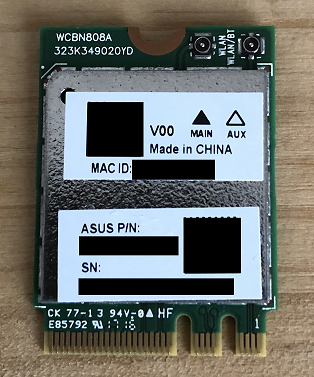Introduction
2x2 MIMO has long been supported in devices with high data communication volumes, such as smartphones, but recently we have begun to hear about 2x2 MIMO in IoT client-side devices as well.
2x2 MIMO itself has been introduced since 11n and is not a new technology, but this time I would like to actually compare the difference in throughput between 1x1 and 2x2 MIMO.
What is MIMO
MIMO stands for Multiple Input Multiple Output. When translated into Japanese, it becomes multi-input multi-output.
If it is 2x2, it means that the input output is performed using two antennas. So it simply doubles the speed.
* Up to 11a/g, even an AP with two antennas actually transmitted and received with one antenna.
*Other advantages of having two antennas include antenna diversity and DBS.
testing environment
The reference board (m.2 Ekey) of Qualcomm's QCA6174A is used this time.
Since the QCA6174A is a 2x2 chip, the transmission rate is fixed for each of 1x1/2x2 and measured.
Click here for the specifications of the QCA6174A.
Documentation and SDKs are available from qualcomm.com. The driver, FW, and supplicant are prepared by the SDK.
Use these to measure throughput.
As for the environment, the QCA6174A and AP (2x2 or more: 11n 20MHz/11ac 80MHz) are connected wirelessly, and the AP and iPerf server are connected by wire.

measurement
Use the following command to fix the transmission rate of the QCA6174A.
iwpriv wlan0 set11NRates <value> iwpriv wlan0 set11ACRates <value>This time, we are only checking the throughput trend of 1x1 and 2x2, so we will measure UDP uplink.
client side
iperf3 -c <IP address> -u -i 1 -t 30 -b 1000M -w 4M -p 9001server side
iperf3 -s -p 9001Compare at the lowest and highest rates of 11n/11ac respectively.
result
| Bandwidth | stream | MCS | throughput |
| 11n HT20 | 1x1 | MCS0 | 4.36Mbps |
| 11n HT20 | 2x2 | MCS8 | 8.64Mbps |
| 11n HT20 | 1x1 | MCS7 | 37.6Mbps |
| 11n HT20 | 2x2 | MCS15 | 70.1Mbps |
| 11ac VHT80 | 1x1 | MCS0 | 26.0Mbps |
| 11ac VHT80 | 2x2 | MCS0 | 53.5Mbps |
| 11ac VHT80 | 1x1 | MCS9 | 354Mbps |
| 11ac VHT80 | 2x2 | MCS9 | 667Mbps |
2x2 has twice the throughput of 1x1 in any band.
11n 20MHz lowest rate 1x1 vs 2x2 : MCS0 vs MCS8 : 4.36 vs 8.64
11n 20MHz highest rate 1x1 vs 2x2 : MCS7 vs MCS15 : 37.6 vs 70.1
11ac 80MHz lowest rate 1x1 vs 2x2 : MCS0 vs MCS0 : 26.0 vs 53.5
11ac 80MHz highest rate 1x1 vs 2x2 : MCS9 vs MCS9 : 354 vs 667
Summary
Roughly twice the throughput was recorded at any rate.
Thus, depending on the interface with the host, using a 2x2 device can achieve twice the throughput of a 1x1 device.
If you're currently using a 1x1 11n/11ac device and aren't satisfied with the performance, why not consider a 2x2 device?
You can check the lineup of Qualcomm Wi-Fi products from this link.
Inquiry
If you have any questions regarding this article, please contact us below.
To Qualcomm manufacturer information Top
If you want to return to the Qualcomm manufacturer information top page, please click below.
